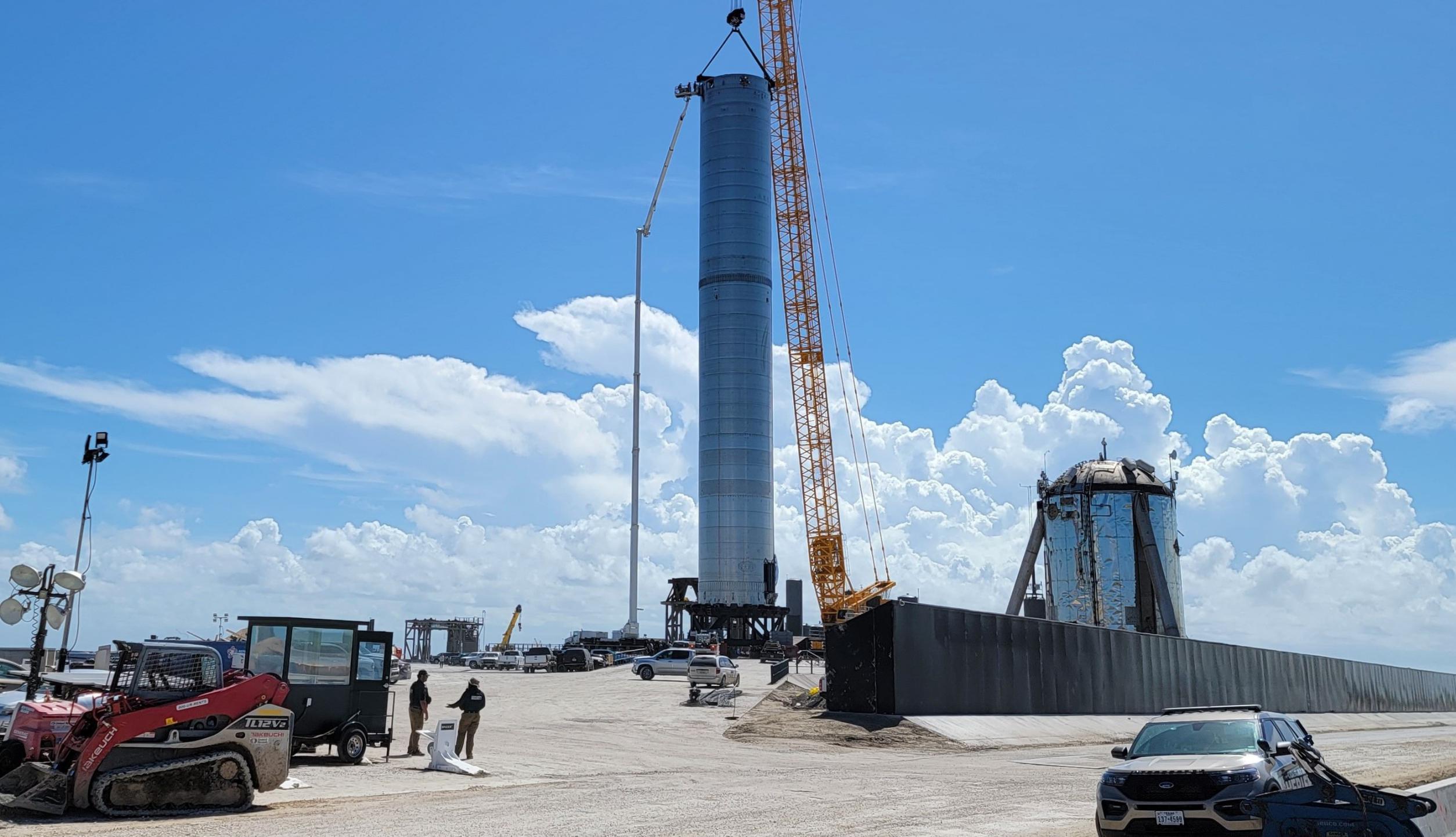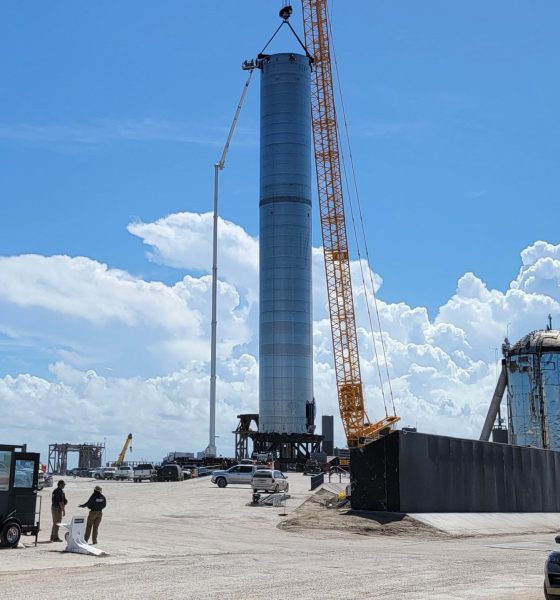

News
SpaceX rolls largest rocket booster ever built to the launch pad
Six weeks after assembly began, SpaceX has completed Starship’s first true Super Heavy booster prototype, rolled it out of its ‘high bay’ nest, and installed the building-sized rocket at the launch pad.
Standing some 65 meters (~215 ft) tall, Super Heavy Booster 3 (B3) is the same height as an entire two-stage Falcon rocket and Dragon spacecraft and is expected to singlehandedly weigh six times more than a fully-fueled Falcon 9 when loaded with liquid oxygen and methane propellant. Once Super Heavies are eventually outfitted with a full 32 Raptors, more engines than any other rocket in history, the booster will also produce more than twice the thrust of NASA’s Saturn V Moon rocket – still the most powerful vehicle ever successfully flown.
Assembled out of 36 steel rings, three tank domes, and dozens of other major components, Super Heavy B3 borrows heavily from the Starship production apparatus SpaceX has built and refined over the last ~18 months. Boosters use the same welding and integration jigs, facilities, and strategies and are built out of the same steel rings, stringers, stiffeners, and dome ‘gores.’
In some ways, Super Heavy boosters are actually a good deal simpler than Starships, which require a custom nose cone, secondary ‘header’ tanks, extra plumbing, actuating flaps, a heat shield with thousands of tiles, and more. Boosters, by comparison, require no heat shield and only need two main tanks made out of identical steel rings. However, all three Super Heavy domes (forward, common, and thrust) are mostly custom or require major modifications on top of parts shared with Starship domes.

Speaking on June 30th, Elon Musk revealed that Booster 3 was “very hard to build” and would be exclusively used for ground tests, reiterating that Super Heavy B4 is currently the first booster scheduled to fly. Curiously, the SpaceX CEO also said that “much of [Super Heavy’s] design” would be changed between Booster 3 and Booster 4, raising questions about what the company hopes to gain from Booster 3 “ground tests.”
Regardless, those tests are now on track to begin as early as Monday, July 6th after SpaceX transported Super Heavy Booster 3 from the factory to the launch pad and rapidly installed the rocket on a test platform on July 1st. Following in the footsteps of Starship, Super Heavy’s first hurdle will likely be an ambient proof test, in which nitrogen gas is used to check for leaks and verify general structural integrity under pressure.
Once complete, Booster 3 will be put through a cryogenic proof test, effectively replacing gaseous nitrogen with its supercooled liquid equivalent to simulate the immense thermal and mechanical stress incurred by similarly cold liquid oxygen and methane propellant. How exactly that test will be done is unclear given that Super Heavy can feasibly hold more than 3100 tons of liquid nitrogen and nowhere near that much storage capacity has been installed. The most important goal of cryo proof testing is to demonstrate that Super Heavy is structurally sound with its tanks pressurized to nominal flight pressures – likely at least 7-8 bar (~100-120 psi).
If successful, there are two possible routes SpaceX could go: more cryogenic proof testing at higher (and thus potentially destructive) pressures or static fire testing with one or several Raptor engines installed. Given Musk’s statement that the first flightworthy Super Heavy booster would implement major design changes, it’s unclear if Booster 3 is of a high enough fidelity to warrant static fire testing or if SpaceX has effectively turned the Super Heavy prototype into a massive ‘test tank’ instead.

Elon Musk
Starlink passes 9 million active customers just weeks after hitting 8 million
The milestone highlights the accelerating growth of Starlink, which has now been adding over 20,000 new users per day.

SpaceX’s Starlink satellite internet service has continued its rapid global expansion, surpassing 9 million active customers just weeks after crossing the 8 million mark.
The milestone highlights the accelerating growth of Starlink, which has now been adding over 20,000 new users per day.
9 million customers
In a post on X, SpaceX stated that Starlink now serves over 9 million active users across 155 countries, territories, and markets. The company reached 8 million customers in early November, meaning it added roughly 1 million subscribers in under seven weeks, or about 21,275 new users on average per day.
“Starlink is connecting more than 9M active customers with high-speed internet across 155 countries, territories, and many other markets,” Starlink wrote in a post on its official X account. SpaceX President Gwynne Shotwell also celebrated the milestone on X. “A huge thank you to all of our customers and congrats to the Starlink team for such an incredible product,” she wrote.
That growth rate reflects both rising demand for broadband in underserved regions and Starlink’s expanding satellite constellation, which now includes more than 9,000 low-Earth-orbit satellites designed to deliver high-speed, low-latency internet worldwide.
Starlink’s momentum
Starlink’s momentum has been building up. SpaceX reported 4.6 million Starlink customers in December 2024, followed by 7 million by August 2025, and 8 million customers in November. Independent data also suggests Starlink usage is rising sharply, with Cloudflare reporting that global web traffic from Starlink users more than doubled in 2025, as noted in an Insider report.
Starlink’s momentum is increasingly tied to SpaceX’s broader financial outlook. Elon Musk has said the satellite network is “by far” the company’s largest revenue driver, and reports suggest SpaceX may be positioning itself for an initial public offering as soon as next year, with valuations estimated as high as $1.5 trillion. Musk has also suggested in the past that Starlink could have its own IPO in the future.
News
NVIDIA Director of Robotics: Tesla FSD v14 is the first AI to pass the “Physical Turing Test”
After testing FSD v14, Fan stated that his experience with FSD felt magical at first, but it soon started to feel like a routine.

NVIDIA Director of Robotics Jim Fan has praised Tesla’s Full Self-Driving (Supervised) v14 as the first AI to pass what he described as a “Physical Turing Test.”
After testing FSD v14, Fan stated that his experience with FSD felt magical at first, but it soon started to feel like a routine. And just like smartphones today, removing it now would “actively hurt.”
Jim Fan’s hands-on FSD v14 impressions
Fan, a leading researcher in embodied AI who is currently solving Physical AI at NVIDIA and spearheading the company’s Project GR00T initiative, noted that he actually was late to the Tesla game. He was, however, one of the first to try out FSD v14.
“I was very late to own a Tesla but among the earliest to try out FSD v14. It’s perhaps the first time I experience an AI that passes the Physical Turing Test: after a long day at work, you press a button, lay back, and couldn’t tell if a neural net or a human drove you home,” Fan wrote in a post on X.
Fan added: “Despite knowing exactly how robot learning works, I still find it magical watching the steering wheel turn by itself. First it feels surreal, next it becomes routine. Then, like the smartphone, taking it away actively hurts. This is how humanity gets rewired and glued to god-like technologies.”
The Physical Turing Test
The original Turing Test was conceived by Alan Turing in 1950, and it was aimed at determining if a machine could exhibit behavior that is equivalent to or indistinguishable from a human. By focusing on text-based conversations, the original Turing Test set a high bar for natural language processing and machine learning.
This test has been passed by today’s large language models. However, the capability to converse in a humanlike manner is a completely different challenge from performing real-world problem-solving or physical interactions. Thus, Fan introduced the Physical Turing Test, which challenges AI systems to demonstrate intelligence through physical actions.
Based on Fan’s comments, Tesla has demonstrated these intelligent physical actions with FSD v14. Elon Musk agreed with the NVIDIA executive, stating in a post on X that with FSD v14, “you can sense the sentience maturing.” Musk also praised Tesla AI, calling it the best “real-world AI” today.
News
Tesla AI team burns the Christmas midnight oil by releasing FSD v14.2.2.1
The update was released just a day after FSD v14.2.2 started rolling out to customers.

Tesla is burning the midnight oil this Christmas, with the Tesla AI team quietly rolling out Full Self-Driving (Supervised) v14.2.2.1 just a day after FSD v14.2.2 started rolling out to customers.
Tesla owner shares insights on FSD v14.2.2.1
Longtime Tesla owner and FSD tester @BLKMDL3 shared some insights following several drives with FSD v14.2.2.1 in rainy Los Angeles conditions with standing water and faded lane lines. He reported zero steering hesitation or stutter, confident lane changes, and maneuvers executed with precision that evoked the performance of Tesla’s driverless Robotaxis in Austin.
Parking performance impressed, with most spots nailed perfectly, including tight, sharp turns, in single attempts without shaky steering. One minor offset happened only due to another vehicle that was parked over the line, which FSD accommodated by a few extra inches. In rain that typically erases road markings, FSD visualized lanes and turn lines better than humans, positioning itself flawlessly when entering new streets as well.
“Took it up a dark, wet, and twisty canyon road up and down the hill tonight and it went very well as to be expected. Stayed centered in the lane, kept speed well and gives a confidence inspiring steering feel where it handles these curvy roads better than the majority of human drivers,” the Tesla owner wrote in a post on X.
Tesla’s FSD v14.2.2 update
Just a day before FSD v14.2.2.1’s release, Tesla rolled out FSD v14.2.2, which was focused on smoother real-world performance, better obstacle awareness, and precise end-of-trip routing. According to the update’s release notes, FSD v14.2.2 upgrades the vision encoder neural network with higher resolution features, enhancing detection of emergency vehicles, road obstacles, and human gestures.
New Arrival Options also allowed users to select preferred drop-off styles, such as Parking Lot, Street, Driveway, Parking Garage, or Curbside, with the navigation pin automatically adjusting to the ideal spot. Other refinements include pulling over for emergency vehicles, real-time vision-based detours for blocked roads, improved gate and debris handling, and Speed Profiles for customized driving styles.








